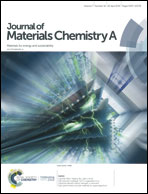Deterministic growth of a sodium metal anode on a pre-patterned current collector for highly rechargeable seawater batteries†
Abstract
Anode-free seawater batteries have emerged as prospective candidates for the next-generation energy-storage cells because of their unique discharge and charge characteristics. To fulfill this purpose, reliable Na metal plating on the current collector surface is an important requirement for improving electrochemical properties. Here, we developed a strategy for deterministic growth of Na metal on a pre-patterned current collector. The different surface energies of the Cu and Al metal surfaces enable the growth of patterned Na islands during electrochemical deposition, which efficiently form a film-like layer of Na metal. In particular, determining an optimum ratio between the metal-pattern diameter and the distance between adjacent pattern edges is the critical factor for producing a decent Na metal pattern array that can facilitate the enhancement of coulombic efficiency and cycling capability of a half-cell structure. Moreover, patterned growth of Na metal is highly beneficial for enhancement of the electrochemical performance of seawater batteries. By using a Na super-ionic conductor separator with a Cu/Al pre-patterned current collector, well-patterned growth of Na islands with improved cycling stability for over 200 cycles can be obtained for anode-free seawater batteries.



 Please wait while we load your content...
Please wait while we load your content...